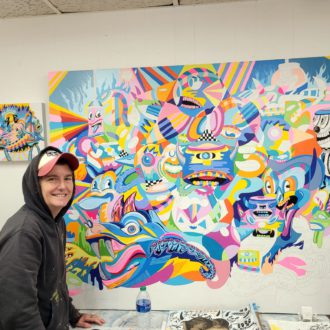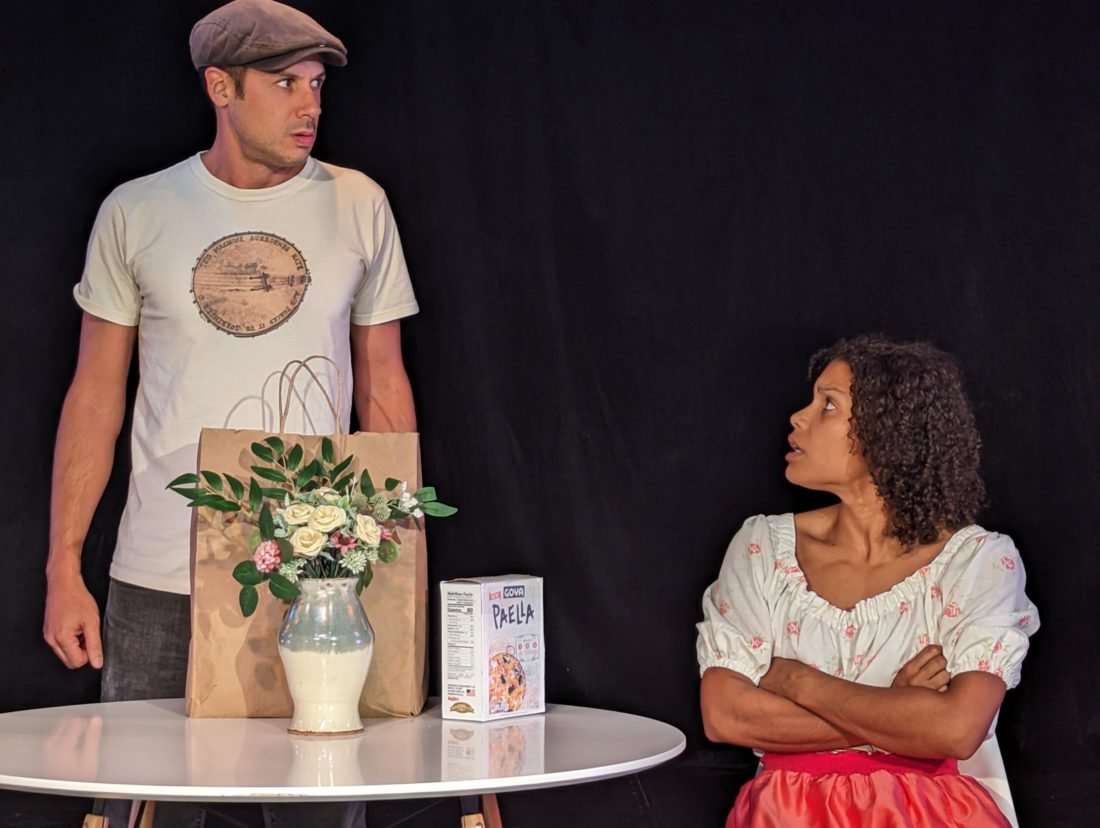Visual artist and Asheville native Jane Allred is one of the last in her friends group to still call Buncombe County home. Many of her close connections are fellow artists who have moved either to the outskirts of the area — within an hour of downtown — or significantly farther away. According to Allred, while a variety of factors prompted their relocations, personal finances played a major role.
No stranger to the hustle, Allred grew up with artist parents and describes covering basic expenses as “running to the finish line, grabbing every coin you can, putting all of it in a giant toilet, flushing it and then starting over.” At 26, she continues to scrape by, operating on a lean budget for the first two weeks of every month until the paycheck from her day job is issued, during which she “hope[s] to God” she sells enough art to “make up for whatever heinous rent” she’s paying for at the time.
But to her, it’s all worthwhile.
“It’s where I grew up — you can’t price me out,” Allred says. “I love it to an unhealthy degree. I’m dug in like a tick. I don’t care how much my rent is — I’ll stay.”
While such dedication is all but necessary to sustain life as an artist in Asheville, it comes with plentiful sacrifices and compromises just to break even. As the cost of living continues to rise, Xpress spoke with a few additional local makers, including a longtime resident who was priced out of the city, to gauge the economic realities of life as a creative person.
Line in the sand
Just Economics of Western North Carolina, an Asheville-based living-wage advocacy nonprofit, has set the living wage rate for Buncombe County in 2024 at $22.10 per hour, or roughly $46,000 a year before taxes. The group defines “living wage” as “the minimum amount that a worker must earn to afford their basic necessities, without public or private assistance.”
This rate represents the lowest wage that will allow an employee working full time to qualify for a one-bedroom apartment in the county, based on a four-year average of the Fair Market Rent released by the U.S. Department of Housing and Urban Development. According to apartments.com data from January, the average rent in Asheville for a one-bedroom apartment is $1,458 per month.

But the living-wage figure doesn’t factor in setting aside money for savings. Financial experts typically recommend having at least three to six months of living expenses in an emergency fund in the event of job loss or an unexpected cost.
“Who has that?” asks visual artist Maxx Feist, who left Asheville in 2021 after nearly two decades living in the city. “No offense to anyone — I’m glad if people do. But I feel like if you become an artist, you make this choice: ‘I’m going to take this gamble.’”
Unfortunately, notes Feist, who uses they/them pronouns, many of the successful artists they know end up “sell[ing] their souls” in the process.
“If you want to make money at it, you have to build this very big online presence that sometimes is not true to who you are. And then you have to continue and consistently make the same thing all the time, and that changes what being creative is in some ways,” Feist says. “It can be so soul sucking to always have to be thinking about the financial aspects of everything.”
The work/art balance
In turn, as local stage actor Kirby Gibson notes, few people in Asheville are full-time artists. She views financial stability for creatives as “feeling the freedom to create without having to sacrifice something that you need to survive.”
After earning a degree in drama from UNC Asheville in 2012, Gibson pursued acting in Chicago but struggled to make ends meet. Three years later, she returned to Asheville.
“Coming back here, it got easier because of [the lower] cost of living,” Gibson says. “But it was one of those [life experiences] that taught me how much I need to get paid an hour to make my rent and budget my groceries. And also the kind of job I need and how many hours I need to work and how many hours I can allow for shows and rehearsals.”
In her second Asheville stint, she’s intentionally worked four days, 30-35 hours per week, giving herself at least one day off from her day job. The blocked off time allows her to go to auditions, learn her lines, catch up on emails and other acting-related tasks without overly draining her energy.
“I have never regretted it and don’t know how I would continue to do what I do if I worked full time,” Gibson says. “I need that extra allowance for my second job, which is being an actor — because that takes up a little more time than the day job.”
Since 2020, Gibson has led the three-person team at the Asheville branch of residential composting service CompostNow. She says that part of the physically demanding job involves being “like garbage men, driving around and picking up stuff and dumping it out and washing all the bins,” but the flexible hours and other perks make it worthwhile.

“It’s a dirty job, which I kind of love. And it’s active and outdoors and it keeps me in shape,” Gibson says. “It feels like honest work, and they pay me a living wage, which is even harder to find. So, I feel very lucky and grateful to have that job and that they can work with me in terms of what I need and my limits. They’ve been very amenable to that.”
Achieving that balance is important to Gibson. She enjoys not feeling the pressure to create in order to make a living because she says doing so has the potential to take the fun out of the process.
“Some people are [focused] in — they’ve got that motivation and they’ve got that laser focus and know exactly that that’s their purpose and what they want to do,” she says.
“But I think just as many people enjoy creating just for the experience of that community you create when you make a piece of art and do theater; or to entertain people who come to see you and tell stories and educate people. And they also enjoy spending time with their family and friends and having a nice job and still having a couple evenings free to, like, enjoy Asheville and hang out and watch movies.”
‘You have to try all of it’
That kind of lifestyle sounds appealing to Matt Williams, who’s ready for more leisure time. After 15 years of running The Eagle Room recording studio, where he produces and engineers albums for a range of artists, as well as playing in various bands, the 39-year-old musician is eyeing a change.
“I did so many all-nighters, and I still do, but that lifestyle of working 24/7 is superhard,” he says. “Now I’m actually looking at still doing [music] and taking less projects, but pivoting into technology since I’m so good at it. I’m looking at degree programs that I can do online to try to get a master’s in software engineering.”
Williams adds that musicians his age and older are having trouble keeping up with the physical demands of regular gigging and that more responsible business practices are necessary to sustain the local industry. He’s networking with local artists to pursue sync licensing, in which songs are used in film and TV projects. The lucrative field pays far more than gigging and has the potential to generate considerable passive income. But for those continuing to play out — himself included — he notes that it’s essential for artists to not compromise when it comes to setting rates for performances. Accepting low offers, he cautions, sets a dangerous standard that hurts one’s peers.

“I’ve had to go to private events, pretty much, to get what I feel like is my value,” Williams says.
While he creates plenty of original music on his own, Williams’ party band, The Royal Suits, proudly plays cover songs. He feels there’s a misconception that artists have to write their own material “to feel like you’re making it.”
“A couple of our members don’t do original music — but this is their passion,” Williams says. “They’ve been playing music their whole life and they found passion in just making sure that we crush and that our project is the best that it could possibly be.”
Allred likewise recommends finding fulfillment through well-paying sources, even if they’re not ideal. She works full time at Madam Clutterbuckets Neurodiverse Universe, where she says she’s fortunate to be able to sell her work while on the clock. But other promotional approaches are necessary.
“I’ve tried just about every website-building platform and every sales application possible. I’ve vended at just about every market I can ever possibly find,” Allred says. “All of it is going to be hit-or-miss. All of it is a toss of the coin. And, unfortunately, as exhausting as it is, you have to try all of it.”
The ever-changing ways in which people purchase art also means makers should keep an open mind about where they sell their work, she says.
“People shut down certain avenues so quickly because it doesn’t work one time,” Allred says. “I have a lot of friends that have co-vended at markets with me. It’s their first time selling their art. They don’t make a sale, and they have never done a market since.”
She continues, “You have to get over the disappointment of an unsuccessful day or an unsuccessful week or an unsuccessful month and just keep trying. You have to take that punch direct to the confidence and get back up and keep going — as hard as that is. Because it sucks when you spend all day at a market and no one even takes a second glance. That’s happened to me at least a dozen times. But I still pay my rent with my art. It doesn’t mean I’m any less. You just have to get over that incredibly awful feeling.”
‘The idea of Asheville’
Feist, who now lives and creates in Savannah, Ga., says the cheaper rent is a major perk. Currently, they pay $1,000 per month, including utilities, for their own apartment. The lower cost of living allows them to also rent a separate studio space. They say having both in Asheville would be highly unlikely, as would a semblance of financial stability.
During their time here, Feist felt connected to the local scene and their identity as “an Asheville artist.” But moving to Savannah made them hustle harder than they would have in Western North Carolina. Rather than focus on one city, as they did — and many other artists do — in Asheville, Feist sells their art all over the South and is working on expanding sales nationwide.
“People are sold on the idea of Asheville,” Feist says. “I love Asheville — don’t get me wrong. But do not struggle just to stay there.”
Though Feist would still love to eventually move back, they note that doing so would mean being part of a less than desirable scene. In addition to the lack of affordable housing and galleries focused on spotlighting new artists, Feist says everyone is in constant competition, struggling against each other to make money. And if one’s art doesn’t sell and you can’t pay rent, resources aren’t in place to retain the kind of people that once made the city an exciting, vibrant spot.
“It’s almost like people have become expendable there, and that’s unfortunate because it was so community driven at one point,” Feist says. “Asheville became too big for what Asheville was. It was so beautiful at one point but I just find it to be a very sad situation.”






Feist is my favorite. Seems surprised that being essentially a one person business requires devoting a lot of time to finances. Then, moves to Savanah but branches out to see in the whole SE because Savanah is too small. Could sell in the SE from asheville for some reason??
Was Thornton Wilder being ironic when he has Horace Vandergelder say in “The Matchmaker” . . .
“A living is made, Mr. Kemper, by selling something that everybody needs at least once a year . . .And a million is made by producing something that everybody needs every day. You artists produce something that nobody needs at any time.”